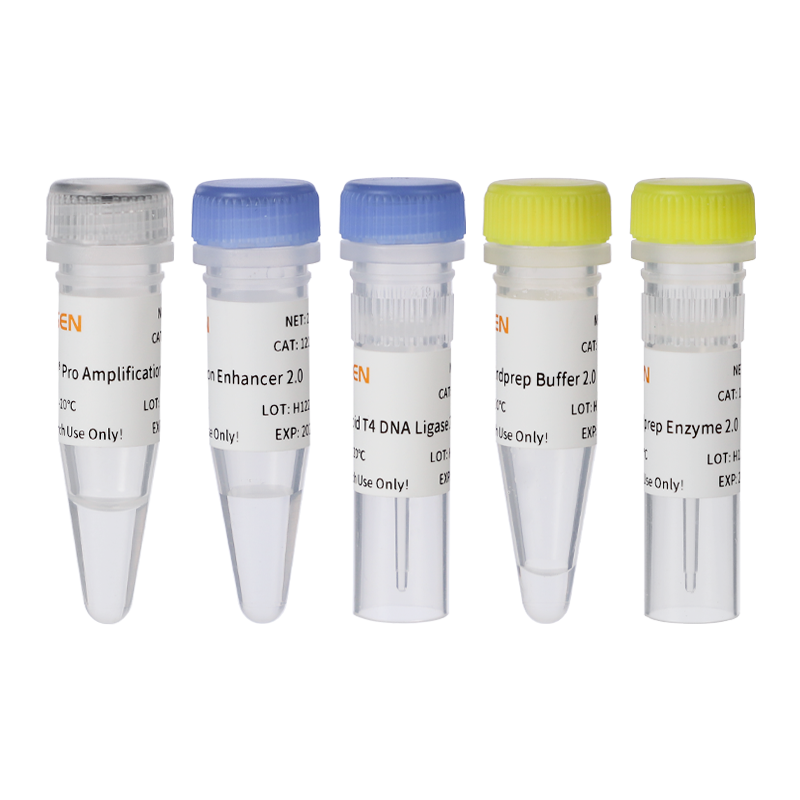Description
Hieff NGSTM DNA Library Prep Kit is a new generation library preparation kit specially developed and designed for Illumina&MGI sequencing platform. On the basis of the previous generation of library preparation kit, this product exhibits higher efficiency in end repair, dA-tailing, and adapter ligation than the previous versions. The high-fidelity enzyme significantly improves the uniformity and fidelity of amplification. The kit is compatible with most DNA sample types, including standard genomic DNA from animals/plants/microorganisms, FFPE samples, cfDNA, and ChIP DNA.
Features
- Broad Sample Compatibility: Supports a wide range of input DNA from 100 pg to 1 µg, covering all common sample types.
- High Adapter Ligation Efficiency: Powered by a novel ligase mutant to minimize adapter dimers and maximize library conversion rates.
- Accurate Mutation Detection: Incorporates a next-generation high-fidelity enzyme to enhance the precision of low-frequency variant detection.
- Excellent Reagent Stability: Single-use library prep reagents remain stable for up to 4 weeks at 4°C and 2 weeks at 25°C, fully compatible with automated workflows
Components
|
Components No. |
Name |
12927ES08 (8 T) |
12927ES24 (24 T) |
12927ES96 (96 T) |
|
|
12927-A |
|
56 μL |
168 μL |
672 μL |
|
|
12927-B |
|
Endprep Enzyme 2.0 |
24 μL |
72 μL |
288 μL |
|
12927-C |
|
Ligation Enhancer 2.0 |
240 μL |
720 μL |
3×960 μL |
|
12927-D |
|
Rapid T4 DNA Ligase 2.0 |
80 μL |
240 μL |
2×480 μL |
|
12927-E |
|
CanaceTM Pro Amplification Mix |
200 μL |
600 μL |
3×800 μL |
Shipping and Storage
This product should be stored at -25~-15℃ for 1 year..
Application
DNA library Preparation; Whole genome sequencing(WGS); whole exome or other targeted capture sequencing; amplicon sequencing; immunoprecipitation sequencing; metagenomic sequencing;
Figures

1. Multi-Species Compatibility
 Figure 1. Library Yield Comparison Across Species
Figure 1. Library Yield Comparison Across Species
Library preparation was performed using 50 ng of genomic DNA from different species. Yeasen’s 12927ES (2G) kit produced equal or higher library yields than 13577ES (1G), and showed superior performance compared to supplier N* and K*.
2. Compatible with Illumina and MGI platforms
Figure 2. Compatibility of UDI Adapters and complete adapter with Illumina and MGI Platforms
3. Excellent Sequencing Data Performance

Figure 3. Comparison of Sequencing Data Quality
Using tumor SNV and wild-type gDNA/ctDNA/FFPE DNA standards with 50 ng/10 ng input and 6-plex hybrid capture (Cancer SLC Panel), Kit 12927 showed lower mismatch, insertion, and deletion rates, indicating higher data accuracy.
4. Stability
 Figure 4. Stability evaluation of the library preparation kit under different storage conditions.
Figure 4. Stability evaluation of the library preparation kit under different storage conditions.
Library yield remained consistent with the control after storage at 4 °C and 25 °C for 1 to 4 weeks, indicating good reagent stability under short-term elevated temperatures.
Documents:
Safety Data Sheet
Manuals
Payment & Security
Your payment information is processed securely. We do not store credit card details nor have access to your credit card information.
Inquiry
You may also like
FAQ
The product is for research purposes only and is not intended for therapeutic or diagnostic use in humans or animals. Products and content are protected by patents, trademarks, and copyrights owned by Yeasen Biotechnology. Trademark symbols indicate the country of origin, not necessarily registration in all regions.
Certain applications may require additional third-party intellectual property rights.
Yeasen is dedicated to ethical science, believing our research should address critical questions while ensuring safety and ethical standards.







